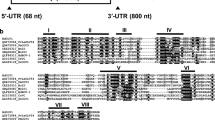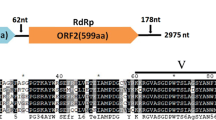Abstract
To our knowledge, there have been no reports of mycoviruses infecting Rhodosporidiobolus odoratus. Here, we describe the sequence of a novel mycovirus isolated from R. odoratus, which was designated "Rhodosporidiobolus odoratus RNA virus 1" (RoRV1). Sequence analysis revealed that RoRV1 has two discontinuous open reading frames (ORFs), ORF1 and ORF2, potentially encoding a hypothetical protein and an RNA-dependent RNA polymerase (RdRp), respectively. Phylogenetic analysis based on RdRp sequences clearly placed RoRV1 in the genus Totivirus, family Totiviridae. The fungus also contains two additional, smaller dsRNAs, which might represent RoRV1 satellite RNAs.


Similar content being viewed by others
References
Ghabrial SA, Suzuki N (2009) Viruses of plant pathogenic fungi. Annu Rev Phytopathol 47:353–384
Pearson MN, Beever RE, Boine B, Arthur K (2009) Mycoviruses of filamentous fungi and their relevance to plant pathology. Mol Plant Pathol 10:115–128
Xie J, Xiao X, Fu Y, Liu H, Cheng J, Ghabrial SA, Li G, Jiang D (2011) A novel mycovirus closely related to hypoviruses that infects the plant pathogenic fungus Sclerotinia sclerotiorum. Virology 418:49–56
King AM, Lefkowitz EJ (eds) (2012) Virus taxonomy: ninth report of the International Committee on Taxonomy of Viruses. San Diego, Elsevier
Goodman RP, Ghabrial SA, Fichorova RN, Nibert ML (2011) Trichomonasvirus: a new genus of protozoan viruses in the family Totiviridae. Arch Virol 156:171–179
Zhai Y, Attoui H, Mohd Jaafar F, Wang HQ, Cao YX, Fan SP, Sun YX, Liu LD, Mertens PP, Meng WS, Wang D, Liang G (2010) Isolation and full-length sequence analysis of Armigeres subalbatus totivirus, the first totivirus isolate from mosquitoes representing a proposed novel genus (Artivirus) of the family Totiviridae. J Gen Virol 91:2836–2845
Zhang P, Liu W, Cao M, Massart S, Wang X (2018) Two novel totiviruses in the white-backed planthopper, Sogatella furcifera. J Gen Virol 99:710–716
Valerio E, Gadanho M, Sampaio JP (2002) Sporobolomyces odoratus sp. nov., a new species in the Sporidiobolus ruineniae clade. FEMS Yeast Res 2:9–16
Lorenzini M, Zapparoli G (2019) Yeast-like fungi and yeasts in withered grape carposphere: characterization of Aureobasidium pullulans population and species diversity. Int J Food Microbiol 289:223–230
You L, Yu S, Liu H, Wang C, Zhou Z, Zhang L, Hu D (2019) Effects of biogas slurry fertilization on fruit economic traits and soil nutrients of Camellia oleifera Abel. PLoS ONE 14:e0208289
Morris TJ, Dodds JA (1979) Isolation and analysis of double-stranded RNA from virus-infected plant and fungal tissue. Phytopathology 69:854–858
Zhong J, Zhou Q, Hu Y, Zhu HJ, Da Gao B (2016) Molecular identification of a novel victorivirus from the phytopathogenic fungus Nigrospora oryzae. Virus Genes 52:156–159
Zhu HJ, Chen D, Zhong J, Zhang SY, Gao BD (2015) A novel mycovirus identified from the rice false smut fungus Ustilaginoidea virens. Virus Genes 51:159–162
Lambden PR, Cooke SJ, Caul EO, Clarke IN (1992) Cloning of non-cultivatable human rotavirus by single primer amplification. J Virol 66:1817–1822
Sohpal VK, Dey A, Singh A (2010) MEGA biocentric software for sequence and phylogenetic analysis: a review. Int J Bioinform Res Appl 6:230–240
Baeza M, Bravo N, Sanhueza M, Flores O, Villarreal P, Cifuentes V (2012) Molecular characterization of totiviruses in Xanthophyllomyces dendrorhous. Virol J 9:140
Kondo H, Hisano S, Chiba S, Maruyama K, Andika IB, Toyoda K, Fujimori F, Suzuki N (2016) Sequence and phylogenetic analyses of novel totivirus-like double-stranded RNAs from field-collected powdery mildew fungi. Virus Res 213:353–364
Khalifa ME, MacDiarmid RM (2019) A novel totivirus naturally occurring in two different fungal genera. Front Microbiol 10:2318
Funding
This study was funded by grants from the National Natural Science Foundation of China (31760015), the Science and Technology Foundation of Guizhou Province ([2017]1153), the Bureau of Science and Technology of Guiyang ([2017]5-24), the Engineering Research Center of Medical Biotechnology, Guizhou Medical University (2016002), and the Immune Cells and Antibody Engineering Research Center of Guizhou Province (KY-2017-017).
Author information
Authors and Affiliations
Corresponding authors
Ethics declarations
Conflict of interest
The authors declare no competing interests.
Ethical approval
This article does not contain any studies involving human participants or animals.
Additional information
Handling Editor: Ioly Kotta-Loizou.
Publisher's Note
Springer Nature remains neutral with regard to jurisdictional claims in published maps and institutional affiliations.
Rights and permissions
About this article
Cite this article
Zhang, T., Cai, X., Zeng, Z. et al. A novel totivirus isolated from the phytopathogenic fungus Rhodosporidiobolus odoratus strain GZ2017. Arch Virol 165, 1911–1914 (2020). https://doi.org/10.1007/s00705-020-04684-6
Received:
Accepted:
Published:
Issue Date:
DOI: https://doi.org/10.1007/s00705-020-04684-6




